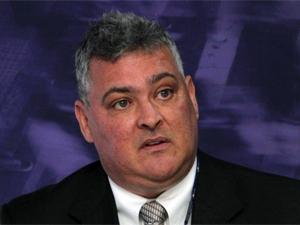
As barriers to entry drop and the available infrastructure improves, new players will enter the market, bringing fresh services, international best practices, and driving competition. One obvious area of improvement has been SA's international connectivity, with the opening of submarine cables like Seacom and WACS. With an abundance of bandwidth bringing prices down and service levels up, SA is a much more attractive investment prospect for international service providers and their multinational clientele. But it's not just SA - those cables are delivering connectivity to several African countries on their way up the East and West coasts, opening the continent to expansion from a South African base.
British Telecom (BT) is one example of this in action. The company has been present in South Africa for a number of years, but is now ramping up its activities. BT is a global telecom giant with an expansive service portfolio and several customers, with a presence in Africa, and SA in particular. It has earmarked the African markets for growth, and has looked to local infrastructure providers for the platforms to bring its services to market rapidly, and at a service level consistent with the high demands it expects across the globe. The model is sound and relatively low-risk, and if it takes off, South African businesses can expect to see other European, American and Asian service providers lining up to provide services.
What makes it work is open access to the basic components needed to deliver high-value (and high-margin) services - connectivity and hosting infrastructure. In the case of a foreign player entering a market, the options are build your own, share with an existing provider, or make use of neutral, open-access facilities. Building infrastructure is expensive, time-consuming and very risky, and sharing is competitively disadvantageous. Enter partners Teraco and FibreCo, which provide vendor-neutral, open-access infrastructure, enabling BT to parachute in equipment and skills, and kick-start a global telecom business in a matter of months, rather than years.
FibreCo is the guts of the relationship, providing national connectivity with its fibre networks between the major metropolitan centres. Its footprint is geographically limited, but well supplemented by the many other networks now operating in SA. Dark Fibre Africa, Neotel, Broadband Infraco, MetroFibre...there are many people with cables in the ground, and more is being laid all the time. FibreCo's business model is different from most, in that instead of selling bandwidth, it rents access to the raw fibre pairs, allowing a provider to make whatever use of it they want, without any issues of sharing or contention. To a telecoms provider, that is a particularly attractive proposition, and BT is one of the anchor tenants on FibreCo's network. "The cost of deploying infrastructure is a factor, but it's not the only driver," says Oliver Fortuin, CEO of BT South Africa. "Being in control of our own infrastructure, in terms of service levels and addressing customer demands, is also critical."
The network business is a tough one, and it's no secret that FibreCo hasn't expanded as quickly as it would like. The company is profitable, says FibreCo's CEO Arif Hussain, but with looming questions like the role of government support for InfraCo and its expansion, and competitive surprises like Vodacom acquiring Neotel, expansion may slow further. The company is cautious about selecting new routes with solid business opportunities, not a Quixotic if-you-build-it-they-will-come.
"It's a good time," Hussain says, referring to the rapid expansion of national fibre infrastructure. "In particular, it's a good time for customers. There's much more choice, much more competition, the ecosystem is more diverse in terms of the services available. All that is progressive, but there are big challenges." The challenges are particularly fierce for network providers like FibreCo, in the highly competitive, low-margin business of providing, effectively, plumbing. FibreCo is in the business of building pipes across the country, and then renting them to players operating higher up the value chain.
Pipes and fridges
At the end of the pipes are big fridges. That's how Lex van Wyk, CEO of Teraco, succinctly describes his business: "Teraco is a property provider. We're a big fridge." Teraco provides infrastructure facilities where service providers and large enterprise clients colocate computing and networking gear. The company has no interest in managed services or software as a service - it offers secure, well-connected, and yes, carefully cooled floor space to its customers.
That floor space is in high demand. Its existing capacity of 5 000m^2 is on track to be exhausted in two years' time, Van Wyk says, so the company is doubling it, building as much again at its Isando facility in Johannesburg.
Teraco's appeal, like FibreCo, is its neutral stance. "That immediately eliminates concerns about any conflict of interest," says Fortuin. "Neither FibreCo nor Teraco are likely competitors in anything we consider to be core business." There are many other hosting providers in South Africa, but most are operated by service providers themselves, with whom the likes of BT compete. As a neutral third party, Teraco is an obvious choice for service providers, and indeed many local telecoms players make use of the company's facilities in one way or another. That's also thanks to a smart move by the firm to build out a peering facility, providing fast, cheap interconnectivity between internet providers, open to all comers. The company started out by winning the contract to operate the Durban interconnect centre (DINX) in 2012, the third of its kind in SA (after JINX and CINX in Johannesburg and Cape Town respectively).

Peering points are important in the internet world - if you're communicating with your next-door neighbour who happens to use a different service provider, your messages may route all the way to New York or London and back again. If both of your service providers are connected to a local peering point, they can short-circuit that international route, lowering cost and improving performance greatly. The South African Internet Service Providers Association (ISPA) formed the first peering centre in 1996.
But Teraco's ambitions were considerable larger than operating a domestic exchange, and in 2012, it also formed NAPAfrica. It's an open-access peering facility with African ambitions, servicing South African providers and their customers, with a view to northward expansion on the new fibre backbones. That ambition is part of what makes the company an attractive partner for the likes of BT. "I don't think this was on the table when we first signed up with Teraco," Fortuin says, "but it certainly strengthens the relationship, increasing the footprint and reducing our cost for expanding into Africa."
Low-risk model
With open-access hosting and connectivity, the stage is set for telecom giants to enter the market. They can drop in racks of equipment, light up existing fibre and immediately start servicing existing global customers and then push for new business. That's a low-friction, low-risk model that is hugely appealing in the telecom world, where greenfield infrastructure investments can take decades to show a return (and some never do). Big players like British Telecom, Deutsche Telecom, AT&T, NTT and China Telecom are not phone companies - they're service companies with a host of business products spanning unified communication, managed services, security, business processes, and more.
The local market will respond, and gear up. Consolidation like Telkom/Business Connexion and Vodacom/Neotel will create stronger players, able to compete with the full infrastructure stack and the benefits that brings - lower cost, easier management, greater flexibility. Greater demand will drive investment in infrastructure, to the benefit of FibreCo and its competitors. Teraco is well-positioned to snap up the growing businesses, but is likely to face greater competition, both from new hosting providers, possibly targeting niche markets alongside specialist service providers - financial services, mining, health care, or retail, and also from the hosting operations of the big service providers themselves, and including relative newcomers with unique market entry points, like Pamoja, the cloud-hosting service operated by Seacom. Teraco is positioning for vertical market specialisation too, Van Wyk says, with the establishment of a PCI-compliant hub to attract financial services clients.
Warning bells
There are some flies circling the ointment. South Africa stands to benefit here from improved infrastructure, lower telecoms costs, and as a base for African growth by telecoms players and their clients. But there are lingering questions about the economy, our skills, government's commitment to telecoms infrastructure expansion, the decade-long leadership turmoil at the Department of Communications, the lack of progress in key policy areas like spectrum reallocation, and plenty more.
"It's been an inhibitor to the business, for sure," says BT's Fortuin. "There was an expectation that things would move faster in South Africa, and be slower in Africa. That perspective is changing."
Up north, competitors are queuing up to displace South Africa as the entry point to the continent. Armed with similar access to international bandwidth and strong government support for ICT investment, the likes of Nigeria and Kenya are poised to strike. When IBM targeted Africa for its newest global innovation centre, for example, it was Nairobi that sealed the deal. South Africa has dropped to second place in African GDP behind Nigeria, with indicators like maths and science education rated well below theirs.
But for now, the positive indicators are still bright. Strong, neutral infrastructure and connectivity opens the door to a new generation of telecoms service and international investment, and the commitment from players like BT is good news for the industry.
First published in the October 2014 issue of ITWeb Brainstorm magazine.
Share